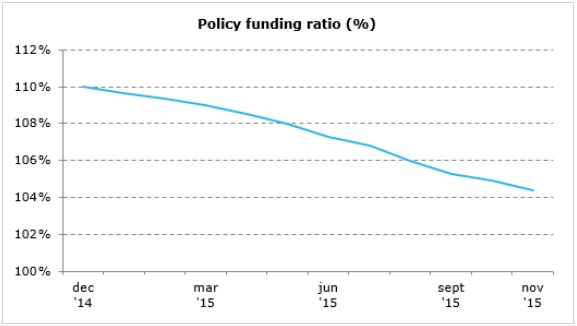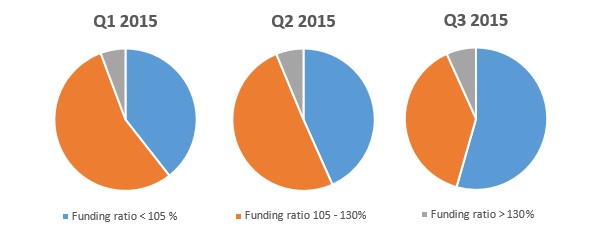Falling interest rates have dragged the average funding level of Dutch pensions below the country’s required level, according to the national regulator.
 Average policy funding ratio. Source: DNBDe Nederlandsche Bank (DNB), which regulates the Netherlands’
€1.1 trillion pension fund system, reported that the average policy funding
ratio fell to 104% in November. Dutch funds are required to maintain a funding
level of at least 105% to be considered solvent.
Average policy funding ratio. Source: DNBDe Nederlandsche Bank (DNB), which regulates the Netherlands’
€1.1 trillion pension fund system, reported that the average policy funding
ratio fell to 104% in November. Dutch funds are required to maintain a funding
level of at least 105% to be considered solvent.
The DNB said that pensions representing 3.4 million active members and 1.7 million retirees had funding ratios below 105%.
DNB data from the end of the third quarter indicated that 129 pensions—more than half of the funds monitored by the regulator—had fallen below this threshold. This marked an increase from 97 in the first quarter.
It follows the DNB’s decision in July to reduce the “ultimate forward rate” (UFR)—used as a discount rate for measuring liabilities—from 4.2% to 3.3%.
At the same time, the DNB has been pressuring pension funds to put in place robust deficit recovery plans by April 1 2016 to ensure they can return to full funding.
At the time of the UFR announcement, the Dutch Pension Federation warned that contributions to pension funds would increase by “an average of 5 percentage points.”
Bernard Walschots, former CIO of Rabobank Pension, previously warned that the revisions to the UFR would “put downward pressure on coverage ratios for the next 10 years.”
ABP—the Netherlands’ (and Europe’s) largest pension—saw its policy funding ratio fall to 101.3% at the end of June 2015, its latest report said. The pension fund for government and education workers posted a 4.1% investment return in the first six months of the year.
The country’s second biggest pension, the health care workers’ fund PFZW, had a policy funding ratio of 99% at the end of the third quarter but has already submitted its deficit recovery plan to the regulator.
The DNB in September said it would allow pensions 12 years to meet the 105% requirement, compared to three years previously.
 Breakdown of Dutch pensions by funding ratio. Source: DNBIn contrast, the UK’s aggregate corporate pension position
improved towards the end of 2015 according to a survey by Mercer.
Breakdown of Dutch pensions by funding ratio. Source: DNBIn contrast, the UK’s aggregate corporate pension position
improved towards the end of 2015 according to a survey by Mercer.
“There is unfortunately considerable scope for downside, with a number of political and economic flashpoints across the globe.”Defined benefit pensions for the country’s 350 largest companies had a combined deficit of £64 billion at the end of December, an improvement from the £78 billion deficit recorded in November. While the combined value of pension assets fell by £6 billion, rising bond yields reduced the total liability by £20 billion.
Despite this positive end to 2015, Ali Tayyebi, senior partner in Mercer’s retirement business, warned that deficits had remained at “broadly the same level now for the last four calendar year ends going back to the end of 2012.”
“This highlights that progress towards a genuine and sustained improvement in funding positions has been a challenge for some time,” he added.
Le Roy van Zyl, principal in Mercer’s financial strategy group, was also cautious. “Looking at the coming year, there is unfortunately considerable scope for downside, with a number of political and economic flashpoints across the globe,” he said. “Pension schemes still have significant exposures to market conditions and both trustees and sponsors are likely to become increasingly focused on how this financial exposure and other costs can be better managed.”
Related: Dutch Pensions Hit as Regulator Moves Discount Rate & Regulator Relaxes Dutch Deficit Rules
